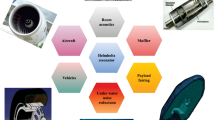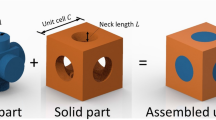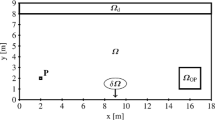Abstract
A low-frequency, omni-directional A0 Lamb wave ElectroMagnetic Acoustic Transducer (EMAT) is developed for applications in guided wave tomography, operating at 50 kHz on a 10 mm thick steel plate. The key objective is to excite an acceptably pure A0 wave mode in relation to the S0 mode, which can also be present at this operating point and is desired to be suppressed by approximately 30 dB. For that, a parametric Finite Element (FE) model of the design concept is implemented in a commercially available FE software, where the bias magnetic field is calculated initially, then combined with the eddy current caused by the induction coil to produce a force. A numerical optimization process employing a genetic algorithm is set up and the EMAT design is optimized to yield an improved A0 mode selectivity. The parameters subjected to optimization are the magnet diameter and the magnet lift-off, which control the direction of the exciting force in the skin depth layer and therefore the mode selectivity. Although there are three possible electromagnetic acoustic interaction mechanisms, the optimisation considers only the Lorentz force, as its performance surface contains a clear optimum and from the optimised design a physical prototype is built. The FE model is validated against measurements on an aluminium plate for the Lorentz force excitation mechanism and on a steel plate for both the Lorentz and magnetisation force. For the steel plate, it is found that only considering the Lorentz force leads to a significant overestimation of the mode selectivity, as the S0 amplitude is underestimated by the Lorentz force, but the A0 amplitude remains mainly uninfluenced. Further, it has been found that additionally including the magnetisation force into the optimisation leads to a better mode selectivity, however, the optimisation drives the optimum to a minimum magnet diameter and therefore reduces the EMAT sensitivity. In a numerical study robustness is shown for fairly large variations of the magnet lift-off and the magnetic permeability. Based on the findings, a two-step model-based design approach is proposed whereby only the Lorentz force is used in the first step for the optimisation and then in a second step, a realistic estimate of the mode selectivity of the optimised design can be obtained by additionally considering the magnetisation force.











Similar content being viewed by others
References
Hou, J., Leonard, K.R., Hinders, M.K.: Automatic multi-mode Lamb wave arrival time extraction for improved tomographic reconstruction. Inverse Probl. 20(6), 1873–1888 (2004)
Miller, C.A., Hinders, M.K.: Classification of flaw severity using pattern recognition for guided wave-based structural health monitoring. Ultrasonics 54(1), 247–258 (2014)
Volker, A., Vos, H.: Experimental results of guided wave travel time tomography. In: Thompson, D.O., Chimenti, D.E. (eds.) Review of Progress in QNDE, AIP Conference Proceedings, vol. 1430(1), pp. 1968–1975 (2012)
Volker, A., Vos, R.: Annular plate inspection using guided wave tomography. In: Thompson, D.O., Chimenti, D.E. (eds.) Review of Progress in QNDE, AIP Conference Proceedings, vol. 1511, pp. 745–752 (2013)
Volker, A., van Zon, T.: Guided wave travel time tomography for bends. In: Thompson, D.O., Chimenti, D.E. (eds.) Review of Progress in QNDE, Chimenti, AIP Conference Proceedings, vol. 1511, pp. 737–744 (2013)
Huthwaite, P., Simonetti, F.: High-resolution guided wave tomography. Wave Motion 50(5), 979–993 (2013)
Huthwaite, P.: Evaluation of inversion approaches for guided wave thickness mapping. In: Proceedings of the Royal Society A: Mathematical, Physical and Engineering Sciences, vol. 470(2166) (2014)
Huthwaite, P., Ribichini, R., Cawley, P., Lowe, M.J.S.: Mode selection for corrosion detection in pipes and vessels via guided wave tomography. IEEE Trans. Ultrason. Ferroelectr. Freq. Control 60, 1165–1177 (2013)
Belanger, P., Cawley, P., Simonetti, F.: Guided wave diffraction tomography within the Born approximation. IEEE Trans. Ultrason. Ferroelectr. Freq. Control 57, 1405–1418 (2010)
Hirao, M., Ogi, H.: EMATs for Science and Industry: Noncontacting Ultrasonic Measurements. Kluwer Academic Publishers, Philip Drive Norwell (2003)
Wilcox, P.D., Lowe, M.J.S., Cawley, P.: The excitation and detection of Lamb waves with planar coil electromagnetic acoustic transducers. IEEE Trans. Ultrason. Ferroelectr. Freq. Control 52, 2370–2383 (2005)
Koch, R.H., May, A., Li, J.: Electromagnetic acoustic transducers for use in ultrasound inspection systems, US Patent 7,426,867 (2008)
Lowe, M., Pavlakovic, B.: DISPERSE user manual (2013). http://www3.imperial.ac.uk/nde/products%20and%20services/disperse. Accessed 3 July 2015
Moon, F.C.: Magneto-Solid Mechanics. Wiley, New York (1984)
Jiles, D.: Introduction to Magnetism and Magnetic Materials. Chapman and Hall, London (1998)
Jackson, J.: Classical Electrodynamics, 3rd edn. Wiley, New York (1998)
Bellac, M., Levy-Leblond, J.M.: Galilean electromagnetism. Il Nuovo Cimento 14, 217–234 (1973)
Chian, C.T., Moon, F.C.: Magnetically induced cylindrical stress waves in a thermoelastic conductor. Int. J. Solids Struct. 17, 1021–1035 (1981)
Thompson, R.B.: A model for the electromagnetic generation of ultrasonic guided waves in ferromagnetic metal polycrystals. IEEE Trans. Sonics and Ultrason. 25, 7–15 (1978)
Brown, W.F.: Magnetic energy formulas and their relation to magnetization theory. Rev. Mod. Phys. 25, 131–135 (1953)
Brow, W.F.: Magnetoelastic Interactions. Springer, New York (1966)
Ribichini, R., Nagy, P.B., Ogi, H.: The impact of magnetostriction on the transduction of normal bias field EMATs. NDT & E Int. 51, 8–15 (2012)
Malvern, L.E.: Introduction to the Mechanics of a Continuous Medium. Prentice-Hall, Englewood Cliffs (1969)
Achenbach, J.D., Xu, Y.: Wave motion in an isotropic elastic layer generated by a time-harmonic point load of arbitrary direction. J. Acoust. Soc. Am. 106, 83–90 (1999)
COMSOL Inc.: Documentation of COMSOL 4.3a (2012). http://www.comsol.com/. Accessed 3 July 2015
Ribichini, R.: Modeling of electromagnetic acoustic transducers, PhD Thesis, Imperial College, London (2011)
Arnold Magnetic Technologies Corporation, Datasheet of N42 Nd-Fe-B Magnets (2009)
Chari, M.V.K., Reece, P.: Magnetic field distribution in solid metallic structures in the vicinity of current carrying conductors, and associated Eddy-current losses. IEEE Trans. Power Appar. Syst. 93, 45–56 (1974)
Nagy, P.B., Simonetti, F., Instanes, G.: Corrosion and erosion monitoring in plates and pipes using constant group velocity Lamb wave inspection. Ultrasonics 54(7), 1832–1841 (2014)
Winter, G.: Genetic Algorithms in Engineering and Computer Science. Wiley, Chichester (1995)
The MathWorks Inc.: Documentation of Matlab R2012b (2012). http://www.mathworks.co.uk/. Accessed 3 July 2015
Instanes, G., Nagy, P.B., Simonetti, F., Willey, C.L.: Measuring wall thickness loss for a structure, Patent, no. US20140208852 A1 (2014)
Acknowledgments
The authors would like to acknowledge funding from the Engineering and Physical Science Research Council (EPSRC) Grant number EP/H040072/1 and the industrial sponsors Shell and Petrobras.
Author information
Authors and Affiliations
Corresponding author
Ethics declarations
Conflicts of interest
The authors are unaware of any potential conflicts of interest.
Human and Animal Rights and Informed Consent
No human participants or animals were harmed in the course of the underlying research.
Rights and permissions
About this article
Cite this article
Seher, M., Huthwaite, P., Lowe, M.J.S. et al. Model-Based Design of Low Frequency Lamb Wave EMATs for Mode Selectivity. J Nondestruct Eval 34, 22 (2015). https://doi.org/10.1007/s10921-015-0296-6
Received:
Accepted:
Published:
DOI: https://doi.org/10.1007/s10921-015-0296-6




